
by Larry Williams | Apr 20, 2015
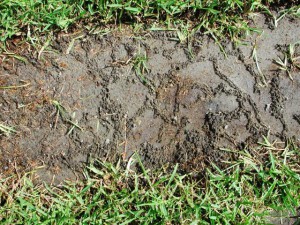
Mole cricket tunnels. Credit: N. Leppla, UF/IFAS
Many people treat their lawn with an insecticide when they see mole crickets in the spring or at the first sign of a brown area in their lawn. What they don’t understand is the biology of this pest.
Mole crickets spend the winter as adults in the soil. As temperatures warm in late February and March, adult mole crickets emerge and begin to mate. Male mole crickets construct a chamber in the soil and chirp to attract female crickets. Attracted females fly to the males. After mating, males die and females fly to a suitable area for egg laying. Mated females begin tunneling and laying eggs in the tunnels. They lay about four clutches of eggs in different areas, averaging 35 eggs per clutch. Female crickets die shortly after laying their eggs.
Use of insecticides during early spring is not recommended because:
- adult mole crickets are not easily killed
- they cause minimal lawn damage during the mating and egg laying process, and,
- reinfestation from subsequent flights is likely.
The best time to treat for mole crickets is during mid-June through July. This will be when eggs have hatched but before the nymphs (immature mole crickets) are large enough to do much damage. Proper timing of the insecticide application is very important to achieve control.
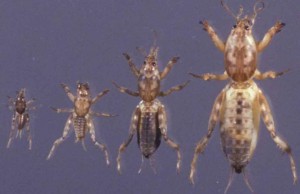
Mole cricket nymphs. Credit: J. Castner, UF/IFAS
If you are not sure if mole crickets are present, you can find out with a soap solution. Mix 1½ fluid ounces of a lemon scented liquid dishwashing soap in two gallons of water in a sprinkling can or bucket. Pour the soapy water over an area approximately four square feet and count the number of mole crickets that emerge. If they are present, it only takes several minutes for mole crickets to crawl to the surface after the soap treatment. Repeat the process around the yard where you suspect mole cricket problems. If you flush an average of two to four crickets per site, treat the lawn with an insecticide. Follow up with spot treatments if any crickets escape the first insecticide treatment. But don’t treat at all if there is no evidence of mole cricket activity.
There are a number of products for mole cricket control in home lawns. Look for insecticides that contain the following active ingredients: bifenthrin, carbaryl, cyfluthrin, deltamethrin, imidacloprid , lambda-cyhalothrin or permethrin.
Before using any product for mole cricket control first identify the problem as mole cricket damage by using the soap flush technique. Then choose an insecticide that lists mole crickets on its label. And finally, read the container carefully for use directions, application techniques, irrigation requirements and precautions.
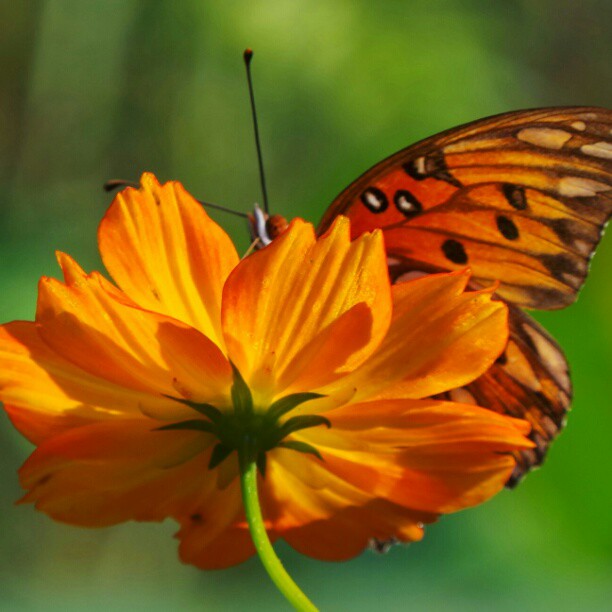
by Taylor Vandiver | Aug 4, 2014
Attracting Butterflies into Your Landscape
Have you been itching to add some life and color into your landscape? Why not plant a butterfly garden?! Butterfly gardens are a great way to add movement and life to an otherwise stagnant landscape. Most butterfly gardens are not only an attractant for our Florida butterflies, but are also a magnet for hummingbirds and beneficial insects. To start your garden all you need are a few key plants.

Gulf Fritillary. Photo Courtesy Scott Jackson.
Incorporate at least one host plant and one nectar plant into your garden. The host plant provides a suitable habitat for the female butterfly to lay her eggs. These eggs will hatch and the baby caterpillars will eat the leaves of the host plant. Host plants are often not as showy as nectar plants, nor are they even necessary to attract adult butterflies. However, while nectar plants invite butterflies into your garden to feed, host plants offer them a reason to stay and reproduce. And you can watch this entire cycle unfold in your own garden!
Most of your butterfly attractant plants will do best in full sun to partial shade. Try not to apply pesticides in areas where you want to maintain healthy caterpillar/butterfly populations. Providing water for butterflies is very important and easily done. One option is to fill a clay tray with sand and then place a rock in the center, where the butterfly can perch. Keep the sand wet, but avoid standing water. Feel free to contact your local extension office for more information on our winged friends!
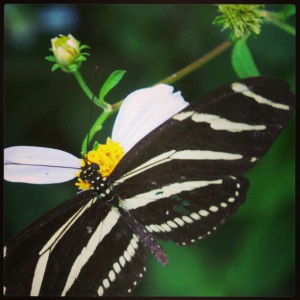
Zebra Longwing, our state butterfly! Photo courtesy Scott Jackson.
Here are a few examples of butterflies and their preferred host plants:
o Host Plants – Fennel, Parsley, Bishopsweed
o Host Plants – Pawpaw
o Host Plants – Wild Lime, Hercules-club, Citrus spp.
o Host Plants – Ash, Black Cherry, Tulip tree, Sweetbay Magnolia
o Host Plants – Partridge Pea, Cassia
o Host Plants – Passion Vines
- Zebra Longwing (State Butterfly of Florida)
o Host Plants – Passion Vines
o Host Plants – Milkweed, Butterfly Weed
Here are nectar plants that will have the butterflies swarming to your garden:
- Firebush
- Milkweed
- Blanket Flower
- Sage (Salvia spp.)
- Butterfly Bush
- Blazing Star
- Yarrow
- Pentas
- Stoke’s Aster
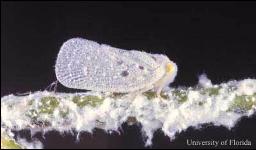
by Alex Bolques | Jun 17, 2014
Homeowner accounts of white fluffy woolly masses on woody ornamentals have been on the rise. They can appear on the ends of a wide variety of woody ornamental branches in the landscape. A closer inspection of these white woolly masses can provide the curious observer with a startling surprise. “It’s Alive!” It moves and seems to jump at you, most likely jumping away from you. Once you have recovered from the mildly frightful encounter, you ask yourself, “What was that?”

Adult citrus flatid planthopper, Metcalfa pruinosa
(Say). Credits: Photograph by: Lyle J. Buss, University of Florida
They are planthoppers (Metcalfa pruinosa), an insect in the order Hemiptera. The common name for this woolly looking planthopper is the citrus flatid planthopper (CFP). As the name implies, they occur on citrus but can also be found on many woody ornamentals and fruit trees. The adult planthopper wing arrangement is tent-like, meaning that the forewings are held over the insect abdomen in a tent configuration.

Nymph of the citrus flatid planthopper, Metcalfa
pruinosa (Say). Credits: Photograph by: Lyle J. Buss,
University of Florida
The nymph, young immature insect, produces the white woolly material that is characteristic of CFP. At first sight, they can be mistaken for mealy bugs, which may look similar since they are covered with cottony white filaments. They can also be mistaken for cottony cushion scale.
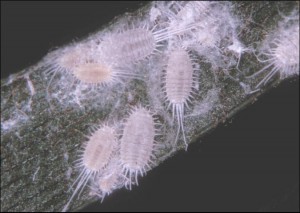
Mealybugs. Credits: James Castner, University
of Florida

Cottony cushion scales, Icerya purchasi, on twig.
Credits: James Castner, University of Florida
In both of these cases of mistaken identities, the insect will not jump or hop around. No chemical control is necessary although sooty mold can occur on heavily populated plants. In that case, a soapy water treatment can be applied.
Follow these links to more information on the citrus flatid planthopper, mealy bugs, and cottony-cushion scale.
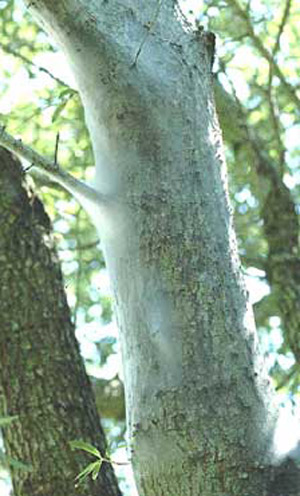
by Larry Williams | Jun 3, 2014
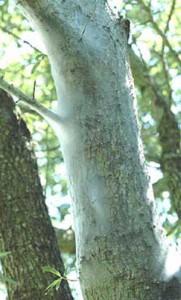
Glistening webbing formed by tree cattle (psocids) Photo credit: Doug Caldwell, University of Florida
Many people are noticing small insects on trunks and branches of their trees. When disturbed, these insects move in a group and are commonly called tree cattle because of this herding habit. They are ¼ inch brownish-black insects with white markings.
Some people assume that these insects will injure their trees but they are harmless. They could be considered beneficial.
These insects are called psocids (pronounced so-cids). They have numerous common names including tree cattle and bark lice. They feed on lichen, moss, algae, fungi, spores, pollen and the remains of other insects found on the tree’s bark. As a result, they are sometimes referred to as bark cleaners.
Tree cattle may form webbing. This webbing is tight against the tree’s trunk and/or limbs. It appears suddenly. The webbing is used as a protection from weather and predators. Underneath you may find psocids.
The glistening webbing may attract a person’s attention resulting in the tree being visually inspected from top to bottom. A dead branch or other imperfections in the tree may be noticed and then wrongly blamed on the tree cattle. I’ve talked to homeowners that sprayed their trees with insecticides or that hired pest control businesses to treat the trees as a result of finding the webbing/psocids. One person told me that he cut down a tree after finding tree cattle. He wrongly assumed that these insects were pests that might move through the area and kill trees. He thought he was doing a good thing.
Adult female psocids lay eggs in clusters on leaves, branches and tree trunks. After hatching, the immature insects (nymphs) remain together under their silk webbing. Adults have wings which are held roof-like over their body. Nymphs are wingless. Psocids usually have several generations per year in Florida.
After seeing the webbing and/or insects, many people insist on spraying insecticides because they believe these insec

Under the webbing live hundreds of psocids. Photo credit: UF/IFAS Jim Castner
ts are damaging their trees. But as mentioned, they are bark cleaners and do not damage trees. If the silk webbing is considered unsightly, a heavy stream of water from a garden hose can be used to wash insects and webbing off infested trees. If nothing is done, the webbing usually goes away in several weeks.
Psocids can be found on many rough-barked hardwood trees and palms. Occasionally, they may be found on wood siding, fence posts or similar areas.
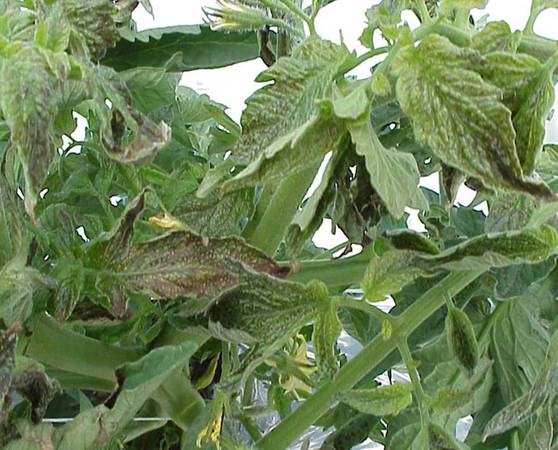
by Eddie Powell | Jun 3, 2014
During this growing season monitor your plants and keep them healthy as a healthy plant will be able to better survive an invader attack.
Nematode populations can be reduced temporarily by soil solarization. It is a technique that uses the sun’s heat to kill the soil-borne pests. Adding organic matter to the soil will help reduce nematode populations as well. Nematodes are microscopic worms that attack vegetable roots and reduce growth and yield. The organic matter will also improve water holding capacity and increase nutrient content.

Tomato Spotted Wilt Virus
Credits: UF/IFAS
If you choose to use pesticides, please follow pesticide label directions carefully. Learn to properly identify garden pests and use chemicals only when a serious pest problem exists. If you have questions please call your UF/IFAS county extension office. We can provide helpful information about insect identification.
Organic gardeners can use certain products like BT(Dipel) to control pests. Please remember not every off-the-shelf pesticide can be used on every crop. So be sure the vegetable you want to treat is on the label before purchasing the product.
Follow label directions for measuring, mixing and pay attention to any pre-harvest interval warning. That is the time that must elapse between application of the pesticide and harvest. For example, broccoli sprayed with carbaryl (Sevin) should not be harvested for two weeks.
Spray the plant thoroughly, covering both the upper and lower leaf surfaces. Do not apply pesticides on windy days. Follow all safety precautions on the label, keep others and pets out of the area until sprays have dried. Apply insecticides late in the afternoon or in the early evening when bees and other pollinators are less active. Products like malathion, carbaryl and pyrethroids are especially harmful to bees.
To reduce spray burn, make sure the plants are not under moisture stress. Water if necessary and let leaves dry before spraying. Avoid using soaps and oils when the weather is very hot, because this can cause leaf burn.
Control slugs with products containing iron phosphate.
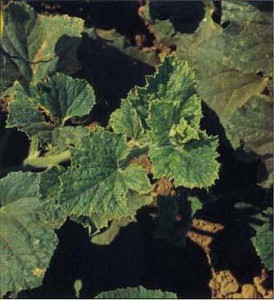
Cucumber Mosaic Virus
Credits: UF/IFAS
Many common diseases can be controlled with sprays like chlorothalonil, maneb, or mancozeb fungicide. Powdery mildews can be controlled with triadimefon, myclobutanil, sulfur, or horticultural oils. Rust can be controlled with sulfur, propiconazole, ortebuconazole. Sprays are generally more effective than dusts.
















